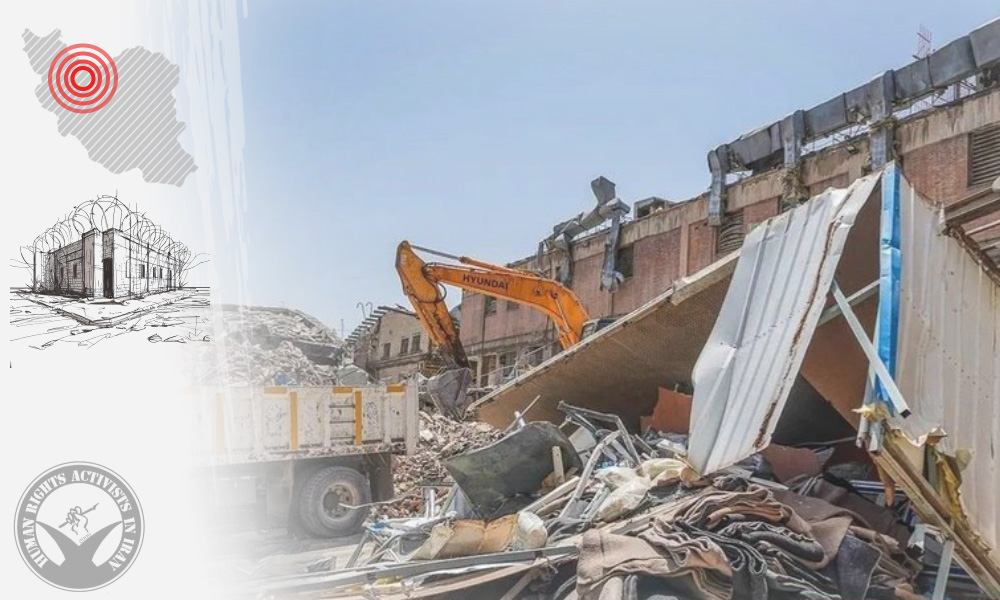HRANA News Agency – On June 23, Israeli military strikes targeted multiple locations in Tehran, including Evin Prison, which sustained several direct hits. A week after the attack, the fate of prisoners held in the facility’s high-security wards remains unknown, fueling growing alarm among their families.
On June 29, without addressing the condition or whereabouts of these detainees, the judiciary spokesperson announced that at least 71 people were killed in the attacks. HRANA has so far verified the identities of 47 of the deceased.
Following the strike, approximately 120 political prisoners were transferred from Evin to other prisons in Tehran Province. However, no information has emerged regarding those held in the prison’s high-security sections—Ward 209 (The Ministry of Intelligence’s detention facility), Ward 2-A (IRGC Intelligence detention facility), and units operated by the Judiciary’s security apparatus. Neither government officials nor state-affiliated media have offered any transparent updates, intensifying the anxiety of families.
Human rights organizations have little to no information about the identities and status of detainees in these high-security wards, where the total population is estimated to exceed 300. These wards operate outside the oversight of Iran’s prison organization, and the lack of accessible records has made it nearly impossible to trace the fate of those detained there.
Footage released by judiciary-affiliated media shows extensive damage to Ward 209 but provides no details regarding its detainees.
Most post-strike reports have focused on the prison’s general wards. According to accounts from those areas, heavily armed special forces stormed the prison in the early hours following the attack. Using force, they removed political prisoners without explaining the reason or destination. Detainees were violently and inhumanely restrained—handcuffed, shackled, and marched into the prison yard in groups—before being loaded onto buses, some of which were damaged and barely operable due to the blasts. As the sounds of missile strikes and air defense continued, prisoners were held for hours under the sun before being transferred under tight security later that night to Greater Tehran Prison. Several detainees likened the transfer to being used as “human shields.”
Beyond structural damage, the attack on Evin Prison resulted in the deaths of multiple inmates and staff. The judiciary spokesperson confirmed that at least 71 people were killed but did not disclose the number of wounded. Among the dead, he said, were prison personnel, military conscripts, detainees, and civilians—family members who had come to visit or follow up on cases at the Evin courthouse.
Below is a list of 47 individuals confirmed dead by HRANA so far:
Evin Prison Staff:
1. Ali Ghanatkar, head of the Evin Prosecutor’s Office and Deputy Security Prosecutor of Tehran;
2. Davood Shirvani Boroujeni, a prison physician;
3. Atefeh Ba’ajzadeh, a counselor and social worker;
4, 5. Zahra Ebadi, an employee of the Evin Prosecutor’s Office enforcement division, along with her 9-year-old child.
Fourteen additional staff members whose identities have been verified include:
6. Mehrad Kheiri
7. Vahid Vahidpour
8. Hassan Shojaei
9. Bahareh Lotfi
10. Hamid Saeedi
11. Hassan Salehi
12. Hassan Nazari Kalur
13. Hossein Ali Ahmadi
14. Rouhollah Tavassoli
15. Pourandokht Sa’adatnejad
16. Mohammad Mir
17. Akram Mohammad Salimi
18. Mahnaz Khosh Kerdar
19. Zohrehsadat (surname unknown).
Military Conscripts:
Confirmed fatalities among conscript soldiers include:
20. Amirali Fazeli
21. Mahan Setareh.
22. Ilya Nobakht
Other confirmed fatalities whose identities have been verified by HRANA, but whose classifications (such as prisoner, staff member, conscript, or visitor) are still under investigation:
23. Fatemeh Siahpush
24. Fatemeh Ghanbari
25. Hossein Zolfaghari
26. Ahmad Morad Arasteh
27. Hossein Yavaryar
28. Hassan Yousefkani
29. Mehdi Shahmoradi
30. Abbas Shafiei
31. Mojtaba Agha Babaei
32. Farhad Fallahi
33. Omid Molashahri
34. Javad Saeedi
35. Mehdi Sarempour
36. Masoud Sabzi
37. Kourosh Molayousefi
38. Hamid Ranjbar
39. Mohammad Hemmati
40. Masoud Karami
41. Seyed Amirhossein Khademi
42. Shirin Esmaeili
43. Zohreh Hosseini
44. Mojtaba Omidi
45. Leila Jafarzadeh
46. Hasti (surname unknown)
47. Hajar Mohammadi
Hajar Mohammadi, the niece of Azizollah Mohammadi, former head of Iran’s Soccer Premier League Organization, and Mehrangiz Imanpour, a painter and former wife of Reza Khandan Mahabadi, a member of the Iranian Writers Association, were also killed.
Mr. Khandan Mahabadi stated: “On Tuesday, June 23, Mehrangiz left her home on Evin Street for a walk. About 40 minutes later, she died in the explosion caused by the attack on Evin Prison. When she didn’t return, we assumed she was injured and began searching for her. Despite visiting several hospitals, we received no information. Other families were also searching for their loved ones. Eventually, on Tuesday, June 24, we discovered at Behesht Zahra Cemetery and the Kahrizak Forensic Center that Mehrangiz had died.”
Read HRANA’s report on the plight of prisoners transferred to other prisons here.



